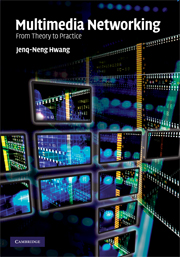Book contents
- Frontmatter
- Contents
- Preface
- Acknowledgements
- List of abbreviations
- 1 Introduction to multimedia networking
- 2 Digital speech coding
- 3 Digital audio coding
- 4 Digital image coding
- 5 Digital video coding
- 6 Digital multimedia broadcasting
- 7 Multimedia quality of service of IP networks
- 8 Quality of service issues in streaming architectures
- 9 Wireless broadband and quality of service
- 10 Multimedia over wireless broadband
- 11 Digital rights management of multimedia
- 12 Implementations of multimedia networking
- Index
6 - Digital multimedia broadcasting
Published online by Cambridge University Press: 26 January 2010
- Frontmatter
- Contents
- Preface
- Acknowledgements
- List of abbreviations
- 1 Introduction to multimedia networking
- 2 Digital speech coding
- 3 Digital audio coding
- 4 Digital image coding
- 5 Digital video coding
- 6 Digital multimedia broadcasting
- 7 Multimedia quality of service of IP networks
- 8 Quality of service issues in streaming architectures
- 9 Wireless broadband and quality of service
- 10 Multimedia over wireless broadband
- 11 Digital rights management of multimedia
- 12 Implementations of multimedia networking
- Index
Summary
Building upon the fast growing technological advance of video compression in the 1980s, along with the availability of affordable fast computing processors and digital memories in the early 1990s, the evolution in use of digital multimedia broadcasting proceeded rapidly (see Table 6.1). The arrival of digital broadcasting was significant; what was happening was not just a simple move from an analog system to a digital system. Rather, digital broadcasting permits a level of quality and flexibility unattainable with analog broadcasting and provides a wide range of convenient services, thanks to its high picture and sound quality, interactivity, and storage capability. European broadcasters initiated the first attempt to implement a complete direct-to-home satellite digital television program delivery infrastructure having a capacity in excess of 100 channels from a single satellite. This was the digital video broadcasting (DVB) project in 1993, and the main standardization work for satellite (DVB-S) and cable (DVB-C) delivery systems was completed in 1994 [1] [2]. The fixed terrestrial version (DVB-T) was soon added to the DVB family to offer one-to-many broadband wireless data broadcasting based on roof-top antenna and the use of IP packets.
All these DVB sub-standards basically differ only in the specifications to the physical representation, modulation, transmission, and reception of the signal. Digital video broadcasting is, however, much more than a simple replacement for existing analog television transmission. More specifically, DVB provides superior picture quality with the opportunity to view pictures in standard format or wide screen (16:9) format, along with mono, stereo, or surround sound.
- Type
- Chapter
- Information
- Multimedia NetworkingFrom Theory to Practice, pp. 181 - 201Publisher: Cambridge University PressPrint publication year: 2009



